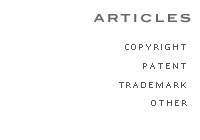

 |
||
 |
Owning Up PRINT Magazine May/June 1999 Frank J. Martinez, Esq. I recently heard from a designer I have known for many years – since long before I went to law school, in fact. His message on my answering machine had that urgent tone usually reserved for emergency communication with fir or police departments. I called him back, virtually certain that this crisis involved ownership issue about creative work and whether it was performed under the work-for-hire doctrine. I was right. The work-for-hire doctrine is so interwoven into the relationship between creativity and commerce that to discuss ownership of copyright works without mentioning it is almost impossible. As a practical matter, every designer and artist encounters the doctrine as soon as they start their careers. Occasionally, known as Title 17 of the United States Code, the Copyright Act, despite its importance, devotes surprisingly little text to defining exactly what is and isn’t a work for hire. In deceptively simple terms, the act states that “a work made for hire is a work prepared by an employee within the scope of his or her employment; or a work specially ordered or commissioned for use as a contribution to a collective work, as a part of a motion picture or other audiovisual work, as a translation, as a supplementary work, as a compilation, as an instructional text, as a test, as answer material for a test, or as an atlas, if the parties expressly agree in a written instrument signed by them that the work shall be considered a work made for hire.” Definitions aside, the essence of the work-for-hire doctrine rests in the combination of the first and last independent clauses: “A work made for hire is a work prepared by an employee within the scope of his or her employment … if the parties expressly agree in a written instrument signed by them that the work shall be considered a work made for hire.” Whenever I discuss the work-for-hire doctrine with a designer, this is usually the point where he digs out his own employment or freelance work agreement, reads it, and recoils in horror. It is paradigmatic that most employment agreements are limited solely to work-for-hire considerations. But the issue isn’t whether this is good or bad for designers. For any creative professional, the real issue should be defining – at the outset – the scope of a work relationship and ownership of the work produced during its course. The notion that an employer can “own” the work of his or her employees is very old. It is not limited to copyright; it can also embrace patentable concepts, trade secrets, and even trademark rights. However, for most designers and artists, work-for-hire questions usually arise within the context of copyrights. Within copyright law, all rights flow from authorship, so a determination of ownership necessarily starts with asking who is the author of the work, and whether someone other than the actual author could be considered the author for copyright purposes. The leading treatise on copyright law, Nimmer on Copyright, states that “there would appear to be no constitutional objection to permitting the assignee of an author to claim copyright in the work assigned.” This notion has been embedded into the copyright law itself at Section 201(b) of the Copyright Act, which states that “in the case of a work made for hire, the employer or other person for whom the work was prepared is considered the author for purposes of this title, and, unless the parties have expressly agreed otherwise in a written instrument signed by them, owns all the rights comprised in the copyright.” In short, ownership of copyright can be transferred in one of two ways: first, by written contract that expressly transfers or assigns copyright in the work; and second, simply by virtue of one’s being an employee. In Aday v. Sony Music Entertainment Inc., Michael Lee Aday, known professionally as Meat Loaf, brought suit against Sony Music and Cleveland Entertainment for unpaid royalties and copyright infringement of his albums Bat Out of Hell, Dead Ringer, and Midnight at the Lost and Found, which were recorded and delivered by Cleveland Entertainment to CBS Records (the predecessor of Sony Records), in 1977, 1981, and 1983, respectively. Aday claimed that he was owed more than $100 million in back royalties as well as title to the copyrights. In this case the court ruled that Aday was never an employee and, as such, ownership of the copyrights could not have passed to Cleveland Entertainment under the work-for-hire doctrine. While the court agreed with Aday that he was never an employee, it did find that Aday’s agreement with Cleveland Entertainment effectively transferred title to the copyrights. Here, despite the questionable intentions of at least one of the parties, the court found a clear work-for-hire agreement that defined ownership of creative work. But what would the court have done if no express contract existed and it was not clear whether Aday was an employee? In 1995, in the case Community for Creative Non-Violence v. Reid, the Supreme Court outlined the following factors for determining whether a sculptor was an employee or an independent contractor: Did the hiring party have a right to control the manner and means by which the work is accomplished? How much skill was required to create the work? What was the source of the instruments and tools used to create the work? Where did the work take place? Additional factors included the duration of the relationship between the parties, whether the hiring party had the right to assign additional projects to the hired party, the extent of the hired party’s discretion over when and how long to work, the method of payment, the hired party’s role in hiring and paying assistants, whether the work was part of the regular business of the hiring party whether the hiring party was in business, and the provision of employee benefits and tax treatment of the hired party. Since almost none of the factors weighed in favor of the hiring party, the court found that Reid was not an employee, and therefore his work could not have been created within the scope of employment. On October 28, 1998, the Digital Millennium Copyright Act was signed into law by President Clinton. The Act is primarily devoted to copyright issues associated with digital technologies and liability issues associated with the Internet. However, the work-for-hire doctrine makes a cameo appearance in a new section granting copyright to a very narrow class of useful designs: boat hulls. Here, employers are given unusually special treatment. In cases where “the design was made within the regular scope of the designer’s employment and individual authorship of the design is difficult or impossible to ascribe and the application so states,” the employer may claim authorship of the work. Thus far, this is merely bad news for those who design boat hulls. However, the real issue here is that this provision seems to shift responsibility for keeping records relating to the life of a creative project from the employer to the designer. This trend should be watched closely by those who work in collaborative fields. Typically, designers are presented with employment agreements when they become permanent employees. For those who freelance, each project usually comes with its own agreement. Based on my own experience in design, these agreements are usually non-negotiable and are presented as a condition of employment. It is important to remember that an agreement that is overreaching and unconscionable in one context may not be in another. There are some signs of excessive employment or work-for-hire agreements. Non-compete clauses or restrictive covenants that restrict the time or geographic location a designer may work after leaving a project are usually frowned upon by the courts. Exceptions may include cases where a designer has special skills or access to a client’s customer list, business plans, or other closely held information such as trade secrets. If appropriate, a work-for-hire agreement should specifically state that the work is being done on a work-for-hire basis. It should define the nature and type of work to be performed, the scope of the hired party’s duties, and the length and scope of any restrictions after the project is concluded. The agreement should not include creative work which is outside the scope of employment. An agreement that gives the hiring party the right to “all ideas, thoughts, inventions, designs, artwork, and any other idea which may be subject to patent, copyright, or trademark protection” should be construed as being overly broad when applied to a junior designer working on a logo. However, such an agreement may not be too broad for a senior designer, production director, or art director where the design brief includes developing a new brand identity as well as technical specifications for a new package configuration. Stated simply, the restrictions should correspond with the nature of the project and the skill of the designer. Taking a few minutes to review and professionally discuss a work agreement with a potential employer will usually reduce confusion and, if conducted properly, the discussion can even lead to a modification of the terms of the agreement.
Home Copyright Trademark Patent Litigation About Us ©2004 The Martinez Group PLLC |
 |